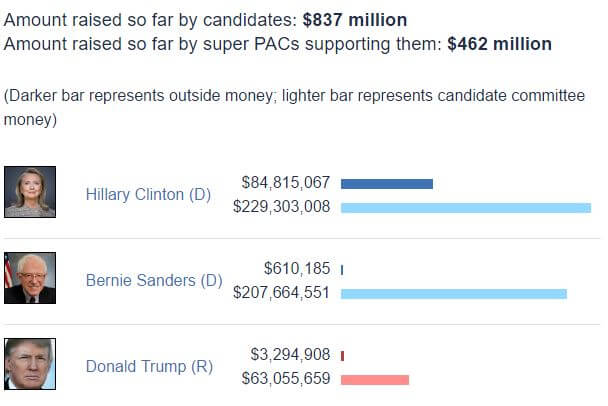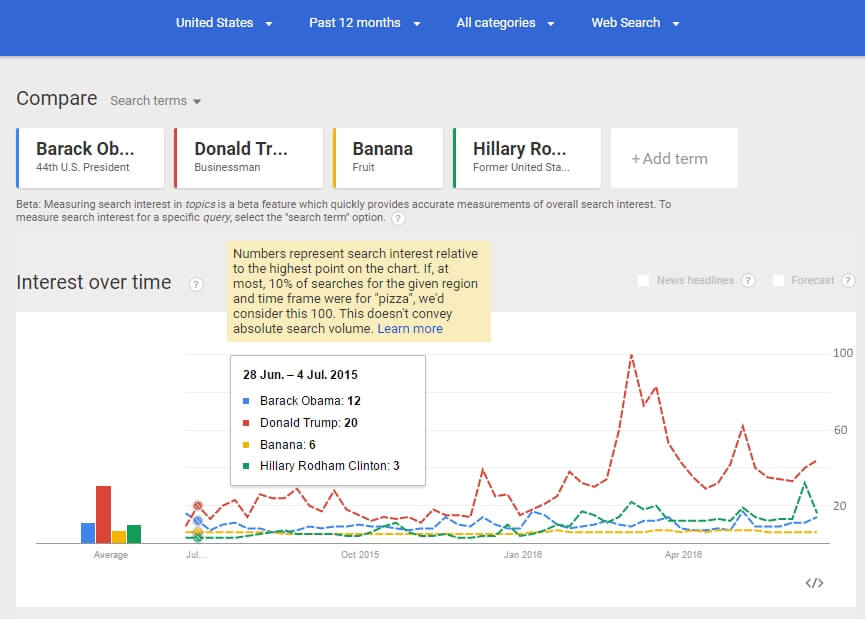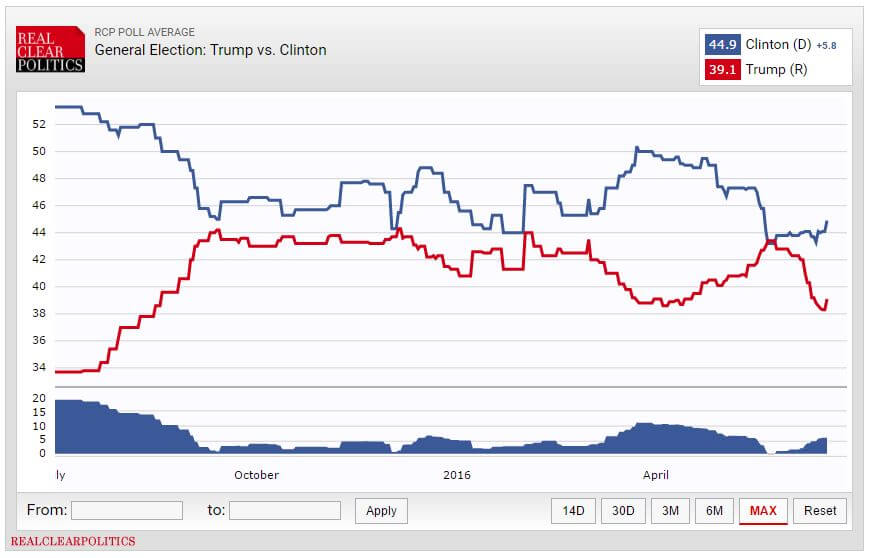US Election: The Marketing of Donald Trump
Who will move in next?
In this essay, I am going to discuss a salient point in Trump’s campaign which is his attempts to be different from other candidates. I will only address that part of Trump’s election campaign in which he is trying to position his brand with the help of points of difference. According to Keller points of difference are strong, favourable, unique brand associations that you are trying establish in order to differentiate your brand from your competitors.
No matter which news channel you turn to in this year’s race for the White House there seem to be only two candidates left worthy of the media’s attention: Hillary Clinton and Donald J. Trump. The other contenders have either stumbled out of the race or are clinging to the last spark of hope, that fate might turn or last minute rule changes could save them.
If you go to to your favourite news site there always seems to be one contestant who is dominating the news coverage slightly more than the other. I am speaking of Donald Trump of course as you might have guessed.
It is hard to believe that it is possible where he is today. Despite the opposition within the Republican Party against him, his strong and less strong rivals, accusations of fraud (Trump University), undiplomatic behaviour and blatant disregard for other politicians and the press. And still, he made it and secured the Republican nomination. Yet, he is a hero to some but a villain to others.
I think as a businessman he knows how important press is, even if it is negative press to stay in the minds of people. He knows how to build a brand and all the countless buildings, golf courses, restaurants as well as his other ventures show that he is not a stranger to (self-)marketing. If we look at his many business ventures you can see that branding is his passion: Trump Card, Trump Tower, Trump Kids, Trump Golf, Trump Hotels, Trump Organisation and although the list could go on it already sounds like a spammy newsletter. In this essay, I am trying to show how Donald Trump is trying to brand himself as an outsider, or a maverick like John McCain tried to label himself during the 2008 election but whose strategies and tactics were flawed, weak and badly executed.
Trump’s communication strategy, on the other hand, isn’t just to say that he is not part of the Washington establishment. Instead, he is acting like someone who disregards the rules of the political business. In marketing terms, he is creating points of difference which set himself apart from the competition. These are features that differentiate a product (it is also possible to brand a person, [easyazon_link identifier=”3473582093″ locale=”UK” tag=”persowebsi0c-21″]David Beckham[/easyazon_link] comes to mind who became known for far more than playing only football) from other competitors. An analogy in the corporate world could be McDonald’s (non-flame-grilled burgers) vs Burger King (flame-grilled burgers). Trump through his actions and speech is positioning himself as an outsider, as someone who is opposed to the political establishment, in the minds of voters which makes it easier for them to see the difference between him and his competition. So far occupying this position in the voters’ minds has proofed valuable to him because he could secure the Republican nomination.
Here is one of Trump’s more famous tweets that show how he has been positioning his brand throughout the campaign.
Pocahontas is at it again! Goofy Elizabeth Warren, one of the least productive U.S. Senators, has a nasty mouth. Hope she is V.P. choice.
— Donald J. Trump (@realDonaldTrump) June 10, 2016
His demeanour is unsuited for a politician when he insults and ridicules a colleague in a condescending manner. Part of his branding is also his simplistic speech, which I don’t want to get into right now, so he can reach a wider audience. A YouTube channel did an excellent analysis of Trump’s speech which shows his ability as a salesman to market ideas. This analysis is a bit scary.
You can find the video below by typing “trump gangsta press conference” (not a joke) into YouTube’s search bar. In it, you can see Trump’s unconventional style when he is calling an ABC reporter a “sleaze” (forward to 38min, 28sec). In recent times, there has been no precedent where a presidential candidate has treated a member of the press like that.
Another part of Trump’s differentiation strategy is to claim that he is “self-funding” his campaign, as opposed to other candidates who are willing to accept donor money from “special interests”. The idea is to position himself as someone who will put the will of the American people first as opposed to a candidate who accepts large sums from outside donors.
I tried to verify Trump’s claim by looking for independent data from OpenSecrets.org and it seems his claim is not entirely correct. However, it seems he receives far less outside money than Hillary Clinton and Bernie Sanders. It is likely that Trump far overestimates the value voters place on a self-funding candidate. If voters were concerned about that Clinton and Sanders would be in a deep quagmire already which isn’t the case. Trump is trying to create a point of difference which is of no value to the voters.
I don't believe I have been given any credit by the voters for self-funding my campaign, the only one. I will keep doing, but not worth it!
— Donald J. Trump (@realDonaldTrump) February 2, 2016

How are the candidates faring on Google?
To gauge interest in the presidential candidates I am referring to internet search trends. Google allows the public to check the relative popularity of search terms with Google Trends. Google Trends has shown in the past that it has some predictive ability, like the correlation between the search for influenza symptoms and doctor visits.
In a similar non-scientific test, I am using Google Trends to plot the search volume over the past year for the names of the candidates relative to their highest search volume. However, there are some caveats that should be noted. While Google is still the biggest search engine in the US, not all voters will be using it and some won’t use the internet at all like older people or technophobes for example. The chart is adjusted to show results for the US only and the timeframe has been narrowed to the past year when the election campaign has started.

Was Trump successful in creating more interest in his campaign than Hillary Clinton? Definitely yes by looking at the numbers and some cynics even say the mass media paid for his campaign. We can see that the number of searches for Hillary Clinton and Donald Trump was approximately the same at the beginning of the campaign but interest in Trump steadily increased peaking around early March, searches for Hillary Clinton, however, stayed consistently lower and judging by the search term the users were neither interested in [easyazon_link keywords=”Hillary Rodham Clinton” locale=”UK” tag=”persowebsi0c-21″]Hillary’s[/easyazon_link] nor [easyazon_link keywords=”Donald J. Trump” locale=”UK” tag=”persowebsi0c-21″]Trump’s books[/easyazon_link]. This may have to do with the fact that she has already been known to the American public for years as a politician while Trump is relatively new on the political stage and potential voters are either curious about or just want to learn more about him. Another factor might be as mentioned earlier Trump’s communication strategy with his sharp comments and non-traditional political agendas which make him such a polarising figure.
Google Adwords: Average Monthly Searches
The above data shows the average number of searches for each candidate which was obtained from Google Adwords. It again shows the searches for Trump are higher than those for Clinton. So it seems that Trump’s strategies and tactics are working for him: create a lot of outcry over his remarks, in return reap plenty of news coverage which helps him win the primaries. Or are they really? Does what helped him kick out his opponents within the Republican party also help him on the national level where he needs to appeal to a broader spectrum of voters? Let’s look at what really counts at the end of the day. What do people think whom they will vote for? And here Donald Trump does not look so good anymore. He is getting beaten by Hillary Clinton in nearly every poll so far. Here is an aggregate of the recent polls.

US Polls
If we look at the poll data the roles are now reversed: Hillary Clinton is in the lead and Donald Trump is trying to catch up. Of course, there are still a couple of months to go until the election, but if Donald Trump wants to win he needs to implement some changes in his campaign immediately or risk losing. Polls have shown to be far more predictive than internet search interest, from which it is hard to deduce the real intent, for example, if someone just searches for the candidates name. As a businessman, he should know that only outcomes matter and here is it where his campaign is lacking. Hillary Clinton, on the other hand, is faring much better in general. She started with a head start in the polls but her numbers took a dive a few months later bringing her dangerously close to Donald Trump’s level but recently she seems to benefit from Trump’s weakness.
Trump should ask himself whether his points of difference are really compelling arguments to convince voters. They are not because they do not resonate with the broader spectrum of voters other than the people he could already convince. Being an outsider and a person who does things differently won’t be enough to win the rest over. He will need to establish points of parity, things that are expected from any presidential candidate like a certain kind of decency towards other people, no matter what their political agenda is.
Trump’s strategy to get news coverage with scandalous comments to boost his popularity among certain segments of voters proofed to be successful for some time but now he needs to pivot and refocus his campaign. Otherwise, the next president will be Hillary Clinton. From a marketing perspective, it will be interesting to see which next trick or idea Trump has up his sleeve. Maybe bury the idea of the “Trump Wall” to appear more reasonable? He himself has already noticed that something is wrong with his campaign. No matter what the outcome of the race to the White House will be, it will remain exciting with two candidates who react like matter and antimatter.
THANK YOU! #AmericaFirst pic.twitter.com/qp07UfnnjM
— Donald J. Trump (@realDonaldTrump) 17 June 2016
What review would be complete without mentioning the candidates’ campaign gear?
[easyazon_image align=”center” height=”399″ identifier=”B01N74JNYK” locale=”UK” src=”https://www.simonmuckle.com/wp-content/uploads/2017/10/51ge2YtOmHL.jpg” tag=”persowebsi0c-21″ width=”500″]
[easyazon_cta align=”center” identifier=”B01N74JNYK” key=”wide-orange” locale=”UK” tag=”persowebsi0c-21″]
Trump chose red as his campaign color which is often associated with force, emotion and strength.
Hillary’s choice was blue which represents a range of positive attributes like stability, trust and truth.
[easyazon_image align=”center” height=”500″ identifier=”B01HOKZWLA” locale=”UK” src=”https://www.simonmuckle.com/wp-content/uploads/2017/10/41T1AvNhkTL.jpg” tag=”persowebsi0c-21″ width=”380″]
[easyazon_cta align=”center” identifier=”B01HOKZWLA” key=”wide-orange” locale=”UK” tag=”persowebsi0c-21″]
